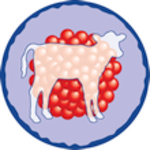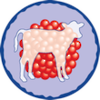AHB01
Histone (H1-enriched)
|
Native - Calf Thymus
|
Histone H1,H2A,H2B,H3 and H4
Uniprot ID: P02253 A7MAZ5 A5PK20 G3N131 P0C0S4 A5D7N2 Q5E9F8 P62803
mRNA RefSeq: NM_001083425 NM_001101066 NM_001098989 NM_174809 NM_001099384 NM_001014389.2 NM_001242571.1 NM_001099724 NM_00114871 NM_173880 Protein RefSeq: NP_001076894 NP_001094536 NP_001092459 NP_777234 NP_001092854 NP_001014411 NP_001229500 NP_001093194 NP_001139343 NP_776305 Autoantibodies against histones (AHAs) are observed in a number of autoimmune diseases. AHA are reported in 50-80% of patients with Systemic Lupus Erythematosus (SLE) being highest in patients with active disease. Although H1 and H2B are the most common targets in SLE, many SLE patients have conformation-dependent AHA, directed against the histone complex. AHA have particular clinical significance for drug-induced lupus, particularly in the diagnosis of antinuclear antibody positive patients receiving procanamide, hydralazine and isoniazide. AHA are also prevalent in Felty’s syndrome, rheumatoid arthritis and juvenile arthritis, scleroderma, systemic sclerosis and mixed connective tissue disease. AHA (predominantly against H1) are also observed in approximately 76% of patients with primary biliary cirrhosis.
Histones are small DNA-binding proteins and the major protein component of the nucleosome. The nucleosome consists of 146 base pairs of DNA wrapped around an octomer of core histone proteins composed of a central tetramer of two H3-H4 dimers flanked by two H2A-H2B dimers. Histone H1 is a linker histone, present between each nucleosome, and is responsible for establishing chromatin structure. The molecular weights of the core histones range from 11,000 to 15,000. Histone H1 is larger, with a molecular weight of 23,000. All of the histones contain many basic amino acids, with histones H3 and H4 being arginine rich, while H2A and H2B are slightly lysine-rich. Histone amino acid sequences are highly conserved between species, even between animals and plants. AROTEC histone antigen is prepared from calf thymus chromatin and contains the five main histones, H1, H2A, H2B, H3 and H4, extracted and purified without the use of harsh denaturing reagents to ensure maximum reactivity with human autoantibodies. AROTEC’s AHB01 has been enriched with the H1 histone, the most common target for autoantibodies, to maximise reactivity against patient sera. Systemic Lupus Erythematosus Drug-induced Lupus Erythematosus Scleroderma Systemic Sclerosis Rheumatoid Arthritis Please log in to view certificates of analysis for this item
0
|










